语言大小和显示样式取决于字符集是英语类语言,字体样式是高还是密集。
Language size and display style vary based on whether a character set is English-like, tall, or dense.
语言注意事项
字形
每种书面语言都使用自己的一组字符,称为字形。
如果您的 UI 使用多种语言,那么排版布局应根据语言而有所不同。不同的语言具有不同的平均字长和高度,这就直接影响了它在 UI 中的显示方式。
Each written language uses its own set of characters called glyphs.
If your UI uses multiple languages, then your typography layout should vary depending on the language. Languages have different average word lengths and heights, affecting how it appears across UIs.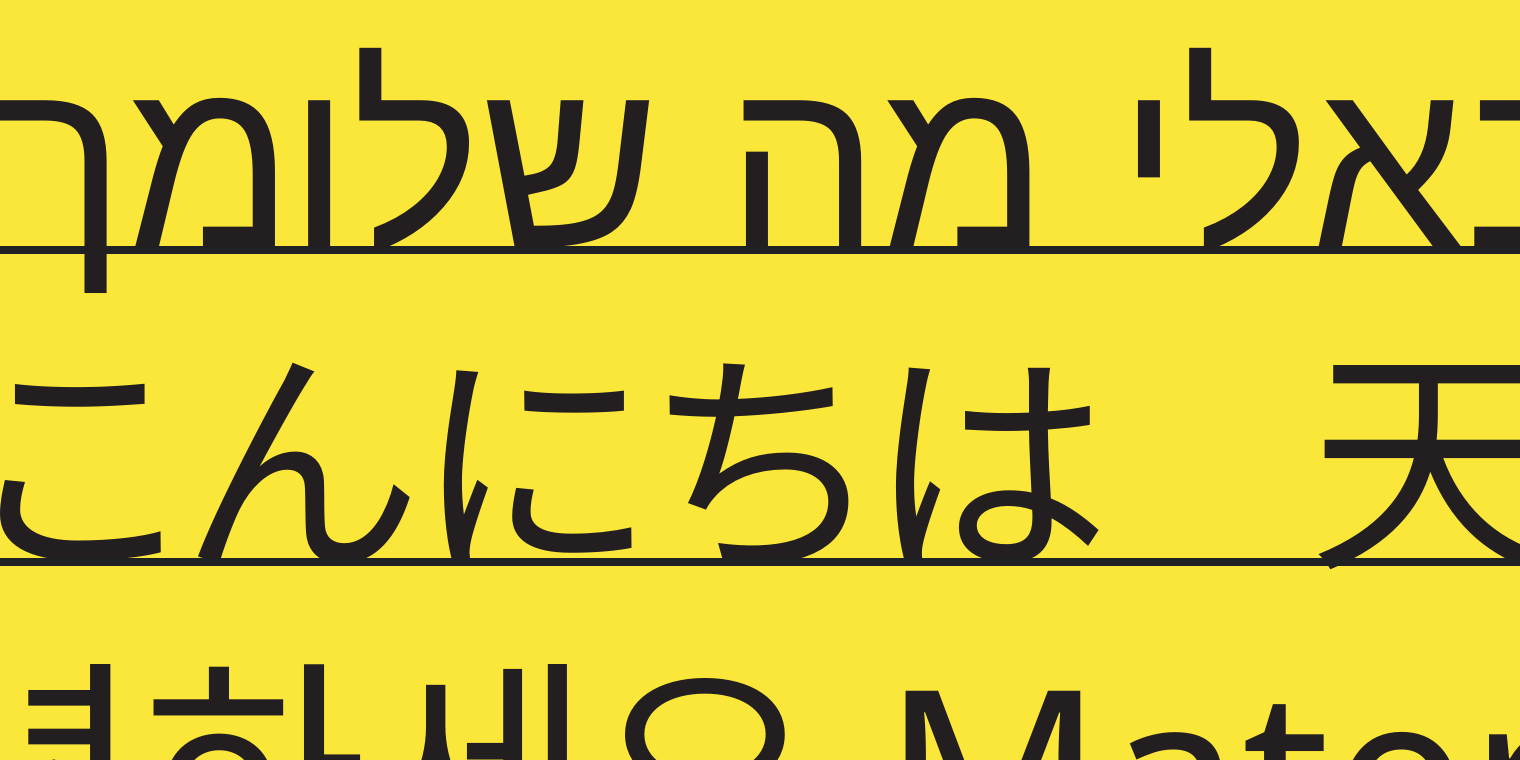
Typographic glyphs
字长
不同语言的字长可能会有很大差异,甚至是那些使用类似字形的字,例如英语和德语。
英语通常比其他欧洲语言更短。例如,德语有许多较长的复合词,需要更多的行或行间距。
English is often shorter than other European languages. For instance, German has many compound words that are longer, requiring more lines or line spacing.
对齐方式
一些书写系统,如阿拉伯语和希伯来语,字符是从右到左进行显示的。这些字体在相同的字体大小下可能看起来比拉丁字体小,需要调整行间距和对齐方式,以便所有语言的 UI 中都能有更好的排版效果。
Some writing systems, like Arabic and Hebrew, are displayed with characters appearing from right to left. Those fonts may appear smaller than Latin ones at the same font-size, requiring adjustments to line spacing and alignment so that the typography works well in that UI for all languages.

Hebrew alignment appears right to left
字高
许多书写系统需要比英语更多的字高,因此您的 UI 应为这些不同的书写系统提供足够的垂直空间。
Many writing systems require more vertical space than English, so your UI should provide sufficient vertical space for these different systems.
虽然越南语是用拉丁语编写的,但它的重音符号会增加某些字母高度,例如ớ。
While Vietnamese is written with Latin, it has accents that add height to some letters, such as ớ.
垂直排版
中国,日本和韩国的排版通常是等宽的,这意味着每个字母占据的空间与其他字母相同。
横向排版的阅读方式通常是:从左到右,从上到下。
在使用垂直排版时,阅读方式通常是:从上到下和从右到左。
Vertical typesetting, though rarely used, can display characters vertically instead of horizontally.
The typography of China, Japan, and Korea is typically monospaced, which means each letter occupies the same amount of space as other letters. It is often set left-to-right, top-to-bottom. It can also be set vertically: top-to-bottom and right-to-left.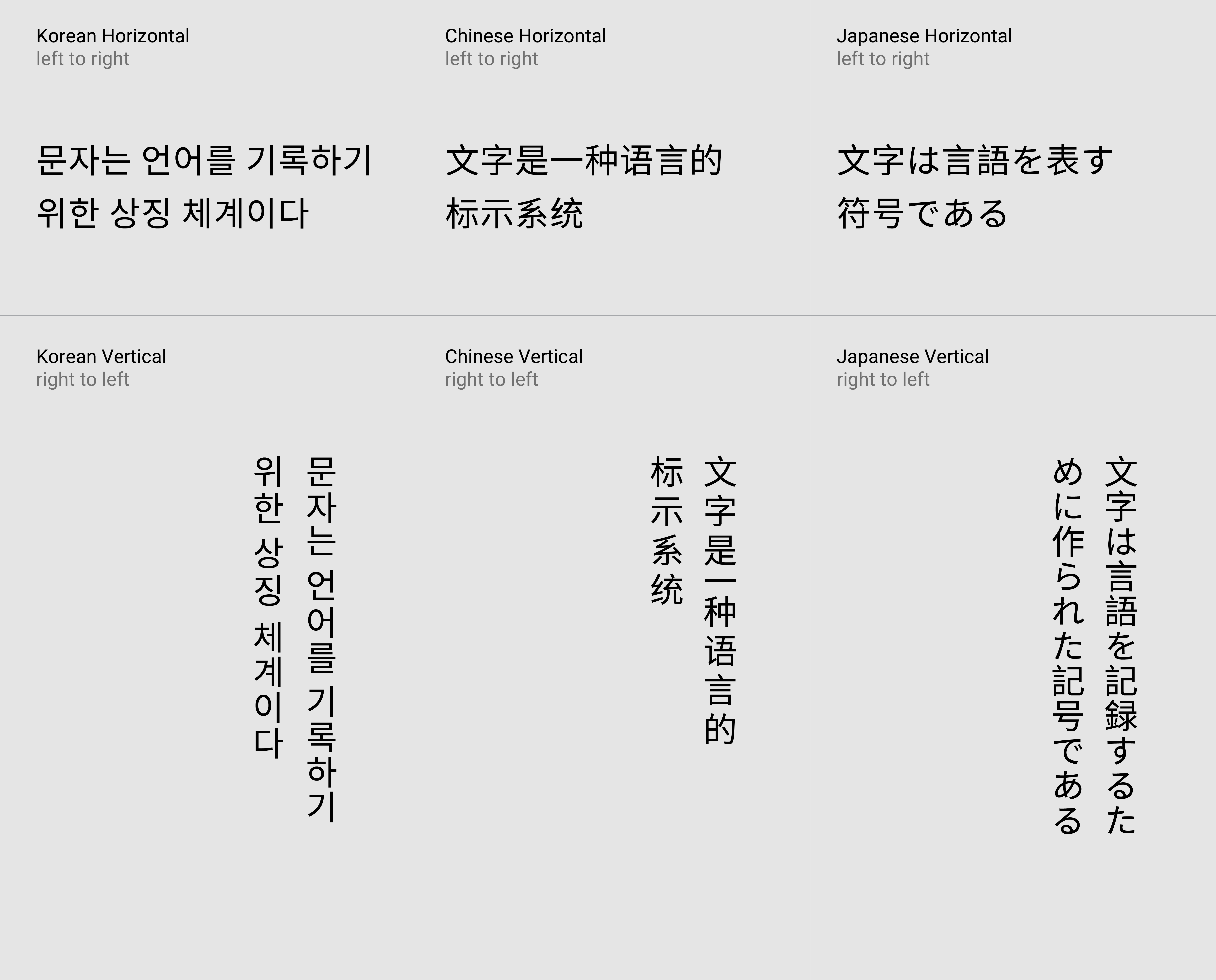
Horizontal and vertical styles of typesetting
语言选项
同一 UI 中可能需要使用多种字体来显示多语言内容,并且需要注意的是每种语言使用的书写系统可能不尽相同。
书写系统可分为三类:
More than one typeface may need to be used in the same UI to display multilingual content, when each language uses a different writing system.
Writing systems can be grouped into three categories:
- 西文类
西欧,中欧,东欧和非洲大部分地区的语言通常用拉丁字母书写。
越南语是一个值得注意的例外,虽然它也是使用拉丁文书写系统,但其重音字形中的重音符号可能会让字母比西欧语言高得多。
希腊语和西里尔语的书写系统与拉丁语非常相似。
The languages of Western, Central, and Eastern Europe and much of Africa are typically written in the Latin alphabet. Vietnamese is a notable exception in that, while it uses a localized form of the Latin writing system, its accented glyphs can be much taller than those found in Western European languages. The Greek and Cyrillic writing systems are very similar to Latin.
- 高
有些语言需要额外的行高以容纳更大的字形,包括南亚和东南亚语言和中东语言,如阿拉伯语,印地语,泰卢固语,泰语和越南语。
Language scripts that require extra line height to accommodate larger glyphs, including South and Southeast Asian and Middle-Eastern languages, like Arabic, Hindi, Telugu, Thai, and Vietnamese.
- 稠密
中文,日文和韩文需要额外行高以容纳更大字形的语言脚本。
Language scripts that require extra line height to accommodate larger glyphs, including Chinese, Japanese, and Korean.
Noto 使用指南
Noto 是 Roboto 未涵盖的所有语言的默认字体。
它源自 Droid,旨在通过兼容的高度和笔划厚度在语言和脚本之间实现视觉上的和谐。
该系列具有在 Unicode 版本 6.0 中定义的 93 种语言。
Noto is the default typeface for all languages not covered by Roboto. Derived from Droid, it’s designed to be visually harmonious across languages and scripts with compatible heights and stroke thicknesses.
The family has 93 scripts defined in Unicode version 6.0.
密集字形的注意事项
与Roboto相匹配,Noto Chinese, Japanese, and Korean (CJK) 都有七个字重,字重设置与英语相同。
当字体大小小于标题样式时,应针对拉丁字形做出相应的比例调整。
Noto Chinese, Japanese, and Korean (CJK) have seven weights that match Roboto, with the same weight settings as English.
Type sizes smaller than title styles should make adjustments to the Latin type scale.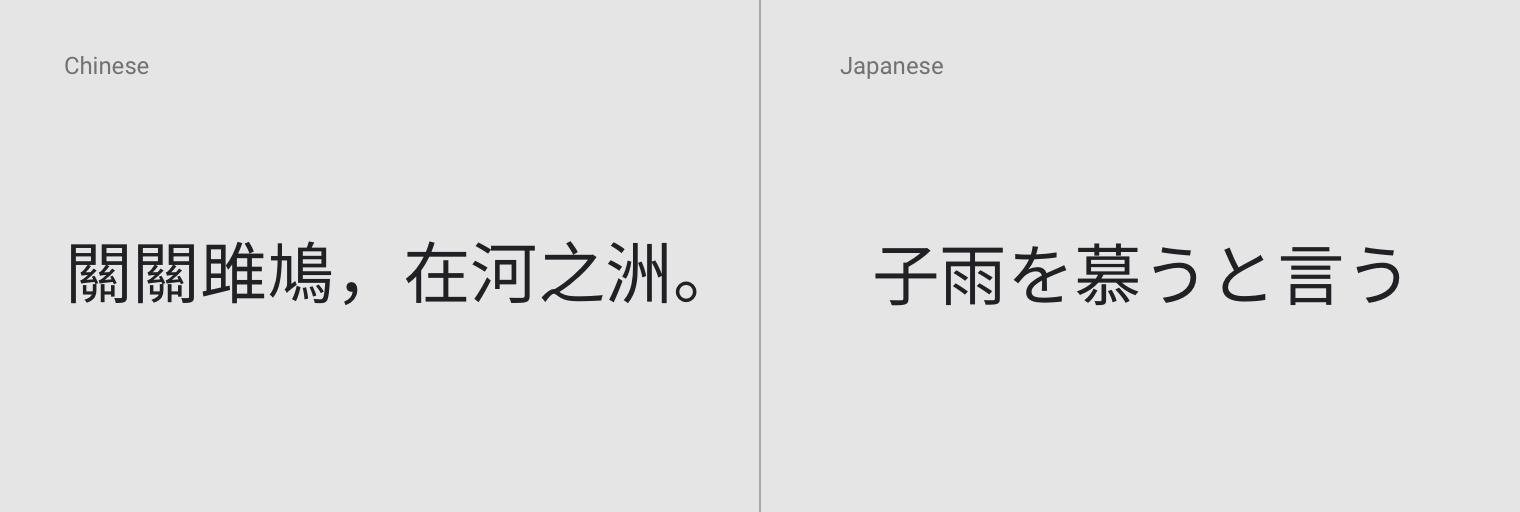
Chinese and Japanese
Line height is slightly larger than Latin-based characters.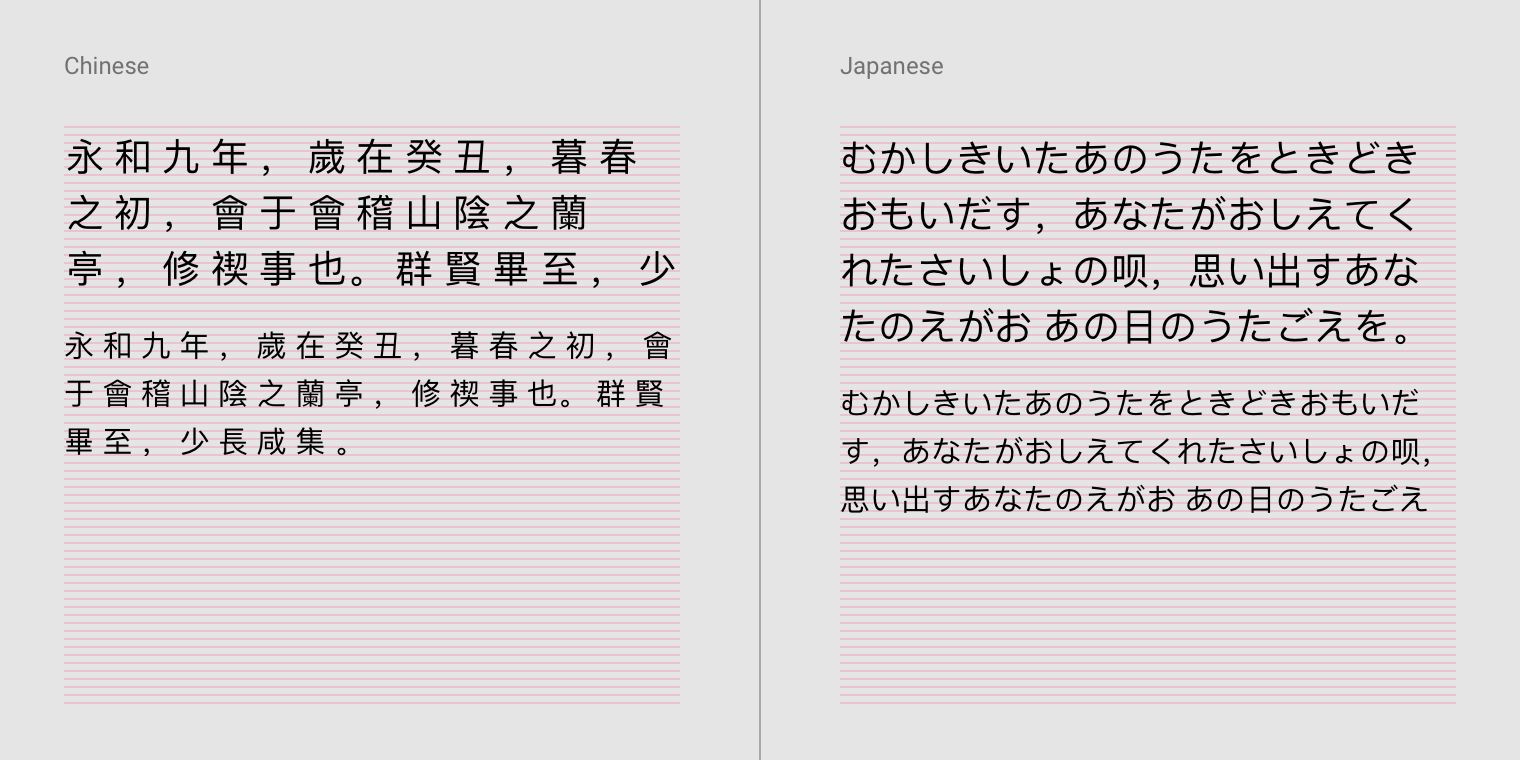
Line height pairing, Chinese and Japanese
高字形的注意事项
Noto 支持南亚,东南亚和中东语言中使用的高字形,包括阿拉伯语,印地语和泰语。
使用正常字重,因为 Noto 不能提供中型字重。高字形需要避免使用粗体,以提升易读性。
当字体大小小于标题样式时,应针对拉丁字形做出相应的比例调整。
Noto supports tall scripts used in South and Southeast Asian and Middle Eastern languages, including Arabic, Hindi, and Thai. Use regular weight, as medium weight is unavailable in Noto. Avoid using the bold weight, as bold is too heavy.
Type sizes smaller than title styles should make adjustments to the Latin type scale.
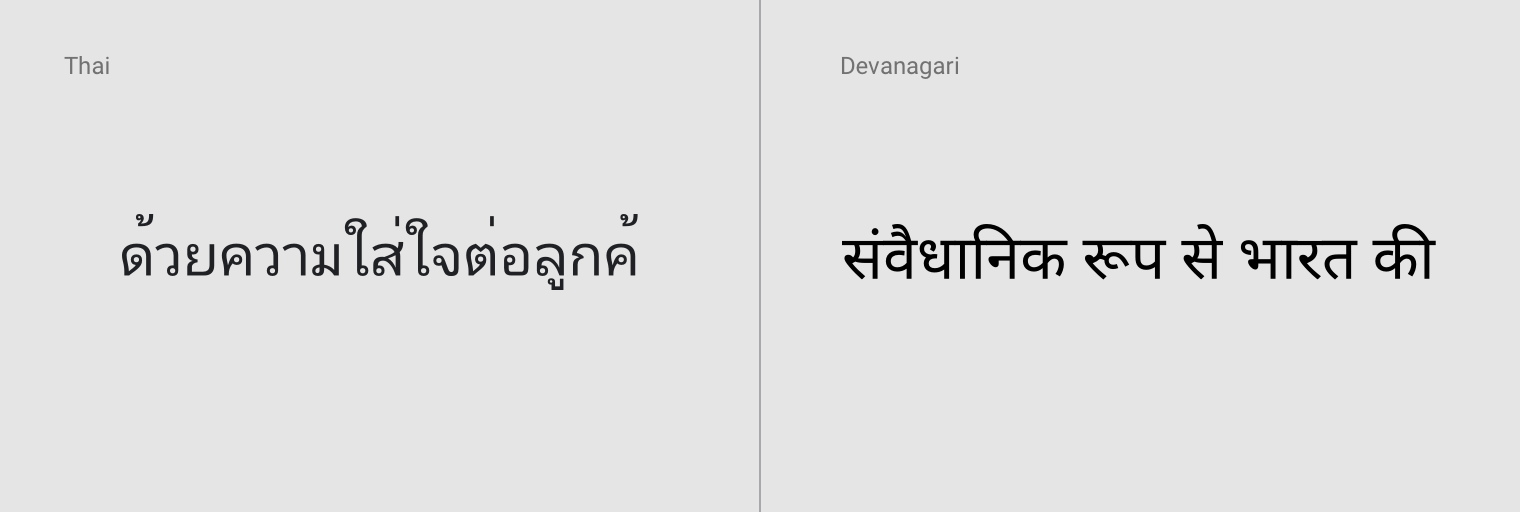
Thai and Devanagari
高字形的行高略大于基于拉丁语的字符。
Tall script line height is slightly larger than Latin-based characters.
Line height pairing example, Thai and Devanagari
语言分类
语言分类参考
为了便于国际化,Google将语言分为三类:英语类、高字形、密集字形。
- 英语类
拉丁语(越南语除外),希腊语,西里尔语,希伯来语,亚美尼亚语和格鲁吉亚语。
- 高字形
南亚和东南亚和中东语言,如阿拉伯语,印地语,泰卢固语,泰语和越南语。
- 密集字形
如中文,日文和韩文。
For ease of internationalization, Google has categorized languages into three categories: English-like, tall, and dense.
English-like: Latin (except Vietnamese), Greek, Cyrillic, Hebrew, Armenian, and Georgian.
Tall: Language scripts that require extra line height to accommodate larger glyphs, including South and Southeast Asian and Middle Eastern languages, like Arabic, Hindi, Telugu, Thai, and Vietnamese.
Dense: Language scripts that require extra line height to accommodate larger glyphs but have different metrics from tall scripts. Includes Chinese, Japanese, and Korean.
| Code | Description | Category |
|---|---|---|
| af | Afrikaans | English-like |
| am | Amharic | English-like |
| ar | Arabic (Modern Standard) | Tall |
| az | Azerbaijani | English-like |
| bg | Bulgarian | English-like |
| bn | Bengali | Tall |
| ca | Catalan | English-like |
| cs | Czech | English-like |
| cy | Welsh | English-like |
| da | Danish | English-like |
| de | German | English-like |
| el | Greek | English-like |
| en | English (US) | English-like |
| en-GB | English (UK) | English-like |
| es | Spanish (European) | English-like |
| es-419 | Spanish (Latin American) | English-like |
| et | Estonian | English-like |
| eu | Basque | English-like |
| fa | Persian | Tall |
| fi | Finnish | English-like |
| fil | Filipino | English-like |
| fr | French (European) | English-like |
| fr-CA | French (Canadian) | English-like |
| gl | Galician | English-like |
| gu | Gujarati | Tall |
| hi | Hindi | Tall |
| hr | Croatian | English-like |
| hu | Hungarian | English-like |
| hy | Armenian | English-like |
| id | Indonesian | English-like |
| is | Icelandic | English-like |
| it | Italian | English-like |
| iw | Hebrew | English-like |
| ja | Japanese | Dense |
| ka | Georgian | English-like |
| kk | Kazakh | English-like |
| km | Khmer | Tall |
| kn | Kannada | Tall |
| ko | Korean | Dense |
| ky | Kirghiz | English-like |
| lo | Lao | Tall |
| lt | Lithuanian | English-like |
| lv | Latvian | English-like |
| mk | Macedonian | English-like |
| ml | Malayalam | Tall |
| mn | Mongolian | English-like |
| mr | Marathi | Tall |
| ms | Malay | English-like |
| my | Burmese (Myanmar) | Tall |
| ne | Nepali | Tall |
| nl | Dutch | English-like |
| no | Norwegian (Bokmål) | English-like |
| pa | Punjabi | Tall |
| pl | Polish | English-like |
| pt | Portuguese (Brazilian) | English-like |
| pt-PT | Portuguese (European) | English-like |
| ro | Romanian | English-like |
| ru | Russian | English-like |
| si | Sinhala | Tall |
| sk | Slovak | English-like |
| sl | Slovenian | English-like |
| sq | Albanian | English-like |
| sr | Serbian (Cyrillic) | English-like |
| sr-Latn | Serbian (Latin) | English-like |
| sv | Swedish | English-like |
| sw | Swahili | English-like |
| ta | Tamil | Tall |
| te | Telugu | Tall |
| th | Thai | Tall |
| tr | Turkish | English-like |
| uk | Ukrainian | English-like |
| ur | Urdu | Tall |
| uz | Uzbek | English-like |
| vi | Vietnamese | Tall |
| zh-CN | Chinese (Simplified, Mandarin) | Dense |
| zh-HK | Chinese (Mandarin, Hong Kong) | Dense |
| zh-TW | Chinese (Traditional, Mandarin) | Dense |
| zu | Zulu | English-like |

